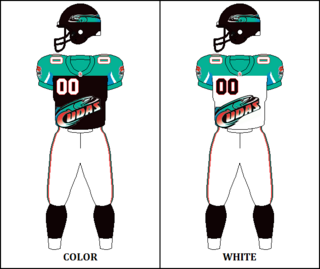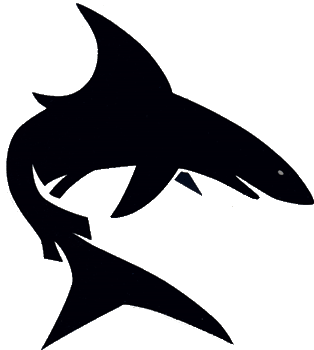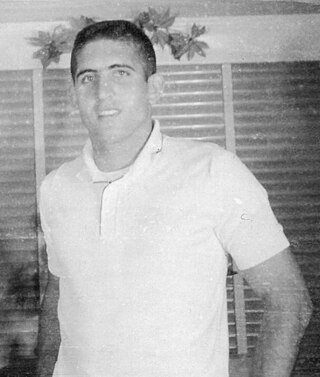Related Research Articles

The World Football League (WFL) was an American football league that played one full season in 1974 and most of its second in 1975. Although the league's proclaimed ambition was to bring American football onto a worldwide stage, the farthest the WFL reached was placing a team – the Hawaiians – in Honolulu, Hawaii. The league folded midway through its second season, in 1975. A new minor football league began play as the World Football League in 2008 after acquiring the rights to its trademarks and intellectual property; it folded in 2011.

The United States Football League (USFL) was a professional American football league that played for three seasons, 1983 through 1985. The league played a spring/summer schedule in each of its active seasons. The 1986 season was scheduled to be played in the autumn/winter, directly competing against the long-established National Football League (NFL). However, the USFL ceased operations before that season was scheduled to begin.

The Birmingham Barracudas were a Canadian football team that played the 1995 season in the Canadian Football League. The Barracudas were part of a failed attempt to expand the CFL into the United States.

The Memphis Southmen, also known as the Memphis Grizzlies, were an American football team based in Memphis, Tennessee. They played in the World Football League (WFL), which operated in 1974 and 1975. They played their home games at Liberty Bowl Memorial Stadium.

The San Antonio Wings were an American football team who played a single season in the World Football League in 1975. The team started as the Florida Blazers in 1974, then moved to San Antonio, Texas in 1975, becoming the San Antonio Wings.

The Jacksonville Sharks were a professional American football team based in Jacksonville, Florida which competed in the World Football League in 1974. The Sharks folded during the 1974 season due to financial difficulties, and were succeeded by the Jacksonville Express which also folded when the league ceased operations during the 1975 season.
The Jacksonville Express were a professional American football team based in Jacksonville, Florida which competed in the World Football League (WFL) in 1975. They were preceded in 1974 by the WFL's Jacksonville Sharks, though the two teams had separate ownership and identities. The Express folded when the league ceased operations during the 1975 season.
The Shreveport Steamer were a professional American football team in the World Football League. The franchise began the 1974 season in Houston, Texas, as the Houston Texans, playing their home games at the Houston Astrodome. Toward the end of the season, the team relocated to Shreveport, Louisiana, and became the Shreveport Steamer. They played at the 30,000-seat State Fair Stadium, now named Independence Stadium. Larry King, of future CNN fame, was one of their broadcasters.

Independence Stadium is a stadium owned by the city of Shreveport, Louisiana and is the home of the Independence Bowl.

Alamo Stadium is a horseshoe-shaped football and soccer stadium in the Monte Vista Historic District of San Antonio, Texas. Nicknamed "The Rock Pile" due to its primarily limestone construction it was completed in September 1940 as a Works Progress Administration project. The stadium is currently owned and operated by the San Antonio Independent School District as a high school football and soccer facility. It has a seating capacity of 18,500, making it the 3rd largest high school stadium in the state of Texas.

John Perry Pardee was an American professional football player and head coach. He played as a linebacker in the National Football League (NFL). As a coach, he is the only head coach to helm a team in college football, the NFL, the United States Football League (USFL), the World Football League (WFL), and the Canadian Football League (CFL). Pardee was inducted into the College Football Hall of Fame as a player in 1986.
The San Antonio Gunslingers were a professional American football team based in San Antonio, Texas, that played in the United States Football League (USFL) in 1984 and 1985. Owned by oil magnate Clinton Manges, the team played its home games in Alamo Stadium and its colors were kelly green, royal blue, silver, and white. Rick Neuheisel was the team's quarterback.

George Ignacio Mira is an American former football quarterback who played in eight National Football League (NFL) seasons for four teams. He then played five seasons in the Canadian Football League (CFL) and the World Football League (WFL).
Edward Eugene Hargett is a former American football quarterback for Texas A&M University who went on to play professionally for the National Football League (NFL)'s New Orleans Saints and Houston Oilers. He later played for the Shreveport Steamer of the World Football League (WFL).
The 1974 World Football League season was the first season of the World Football League.
The 1975 World Football League season was the second and last season of the World Football League. The 1975 season was to be an 18-game season over a twenty-week schedule.
The World Football League was a professional American Football minor league which operated for three seasons, from 2008 through 2010. It was named for the short-lived World Football League which served as a competitor to the NFL in the mid-1970s.
Minor league football, also known as alternative football or secondary football, is an umbrella term for professional gridiron football that is played below the major league level.
Alfred Haywood is a former American football running back who played one season in the National Football League (NFL) for the Denver Broncos. He also played two seasons in the World Football League (WFL) as a member of the Jacksonville Sharks and Jacksonville Express.
The United States Football League was a proposed American professional football minor league founded in 2008 and aimed to begin play on February 20, 2010. The league was also known as the New United States Football League to distinguish it from the 1983–85 league of the same name. During its lifetime, the league had three different owner groups, with the last one aimed to start a season in 2015, but the plans never materialized; it was not until 2022 that a new version of the USFL would come to fruition; none of these versions of the USFL are directly related to each other.
References
- 1 2 3 "The Tuscaloosa News - Google News Archive Search". news.google.com. Retrieved 2023-12-26.
- 1 2 "Ocala Star-Banner - Google News Archive Search". news.google.com. Retrieved 2023-12-26.
- ↑ "Football". Archived from the original on 2010-10-18. Retrieved 2010-06-22.
- ↑ "Home". birminghamprosports.com.
- ↑ "The Dispatch - Google News Archive Search".
- ↑ "Williamson Daily News - Google News Archive Search".
- ↑ https://news.google.com/newspapers?id=WFRJAAAAIBAJ&sjid=8AkNAAAAIBAJ&pg=1074,2572680&dq=american-football-association&hl=en [ dead link ]
- ↑ "Archived copy". Archived from the original on 2015-09-26. Retrieved 2015-06-16.
{{cite web}}: CS1 maint: archived copy as title (link) - 1 2 "The Milwaukee Sentinel - Google News Archive Search". news.google.com. Archived from the original on 2015-09-26.
- ↑ "Sarasota Herald-Tribune - Google News Archive Search". news.google.com. Retrieved 2023-12-26.
- ↑ "The Evening Independent - Google News Archive Search". news.google.com. Retrieved 2023-12-26.
- 1 2 3 4 5 6 7 Bob Gill, with Tod Maher. Outsiders II: Minor League And Independent Football, 1951-1985, p. vii. St. Johann Press, 2010. ISBN 1878282654
- ↑ "1977 AFA Timeline". birminghamprosports.com. Retrieved 2023-12-26.
- ↑ "1978-1981 Shreveport Steamer". 6 May 2018.
- ↑ "1978 AFA Timeline". birminghamprosports.com. Retrieved 2023-12-26.
- ↑ "1979 AFA Timeline". birminghamprosports.com. Retrieved 2023-12-26.
- ↑ "1980 AFA Timeline". birminghamprosports.com. Retrieved 2023-12-26.
- ↑ "1981 AFA Timeline". birminghamprosports.com. Retrieved 2023-12-26.
- ↑ "1982 AFA Timeline". birminghamprosports.com. Retrieved 2023-12-26.
- ↑ "1983 AFA Timeline". birminghamprosports.com. Retrieved 2023-12-26.